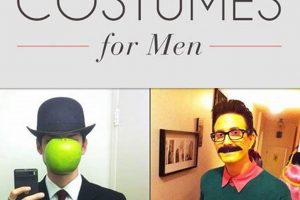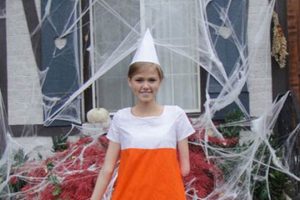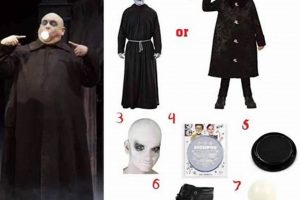Creating a historically inspired garment associated with the French queen involves a do-it-yourself approach to costume construction. This typically includes sourcing fabrics, patterns, and embellishments to replicate the opulent style of the late 18th century. An example would be crafting a panniered skirt, a heavily adorned bodice, and an elaborate wig using readily available materials and online tutorials.
Undertaking such a project allows for personalized expression and creative exploration while offering a cost-effective alternative to purchasing pre-made costumes. Furthermore, it provides an engaging avenue for learning about historical fashion and the social context surrounding this iconic figure. The process fosters a deeper appreciation for the craftsmanship and artistry inherent in historical garments.
The subsequent discussion will delve into crucial aspects of realizing this type of project, covering resources for accurate pattern drafting, fabric selection considerations, techniques for recreating period-appropriate hairstyles, and methods for achieving authentic-looking embellishments.
Tips for a Successful Marie Antoinette Costume DIY Project
The following provides guidance for creating an accurate and aesthetically pleasing garment inspired by the French queen. Careful planning and execution are essential for a satisfactory result.
Tip 1: Prioritize Historical Accuracy. Conduct thorough research regarding silhouette, fabric types, and embellishment styles prevalent during the late 18th century. Consult primary and secondary sources, including portraits, fashion plates, and museum collections.
Tip 2: Select Appropriate Fabrics. Opt for materials such as silk taffeta, brocade, or linen that closely resemble those used in the period. Avoid overly modern or synthetic-looking fabrics, as these detract from the overall authenticity.
Tip 3: Invest in a Reliable Pattern. Utilize historically accurate patterns or adapt existing patterns to achieve the correct shape and construction. Ensure the pattern includes instructions for essential elements such as panniers and a fitted bodice.
Tip 4: Master Essential Sewing Techniques. Familiarize oneself with hand-sewing techniques common during the 18th century, such as backstitch, running stitch, and whip stitch. These techniques contribute to a more authentic and durable garment.
Tip 5: Focus on Embellishments. Pay close attention to details such as lace, ribbons, and artificial flowers. These embellishments were integral to the aesthetic and should be carefully selected and applied to enhance the overall design.
Tip 6: Construct a Supportive Understructure. The correct undergarments, including a chemise, stays (corset), and panniers, are crucial for achieving the iconic silhouette. Ensure these garments are accurately constructed and properly fitted.
Tip 7: Style an Authentic Hairstyle. Research and replicate hairstyles of the period, including voluminous wigs and elaborate decorations. Consider using tutorials and consulting historical sources for guidance.
Adherence to these guidelines will significantly enhance the authenticity and visual impact of the finished garment. Attention to detail and a commitment to historical accuracy are key to a successful outcome.
The subsequent section will address common challenges encountered during such a project and offer potential solutions.
1. Historical Accuracy
The pursuit of authenticity in a recreation of garments associated with the French queen is inextricably linked to the degree of historical accuracy achieved. Deviation from documented practices and material culture significantly impacts the overall credibility of the finished product.
- Silhouette Replication
The distinctive shape of late 18th-century garments relies heavily on understructures such as stays (corsets) and panniers. Inaccurate replication of these elements compromises the overall silhouette, rendering the outer garments less convincing. For instance, omitting panniers results in a drastically different skirt shape, misrepresenting the period aesthetic.
- Fabric Sourcing
The selection of materials plays a critical role. While modern synthetic fabrics may offer cost savings or ease of care, they often lack the texture, drape, and visual qualities of historical textiles like silk taffeta, brocade, or linen. Substituting polyester for silk, for example, immediately diminishes the historical authenticity of the costume.
- Embellishment Fidelity
The lavish embellishments characteristic of the era, including lace, ribbons, and artificial flowers, require careful attention to detail. Mass-produced, modern embellishments often lack the intricate detail and craftsmanship of their historical counterparts. Using inexpensive, machine-made lace instead of hand-made or period-accurate lace detracts from the overall impression.
- Construction Techniques
Historical garments were constructed using specific hand-sewing techniques. While modern machine sewing offers speed and efficiency, incorporating hand-sewing techniques, particularly for visible seams and embellishments, enhances authenticity. Completely machine-sewing a garment intended to replicate historical construction methods will inevitably result in a less accurate representation.
The interplay of these facets underscores the importance of thorough research and meticulous execution in undertaking such a project. A commitment to historical accuracy not only enhances the aesthetic appeal but also provides a deeper appreciation for the craftsmanship and artistry of the original garments. Failure to consider any one element compromises the collective representation; thus, a balanced and informed approach is essential.
2. Fabric Selection
Fabric selection is a pivotal determinant in the success of a “marie antoinette costume diy” project. The visual and tactile qualities of the chosen materials directly influence the accuracy and overall impact of the recreation. Inappropriate fabric choices can undermine even the most meticulously drafted pattern and carefully executed construction. For example, using a modern, heavily textured polyester brocade instead of a smooth, shimmering silk brocade immediately detracts from the intended opulent aesthetic, thereby diminishing the realism of the garment.
The link between the fabrics and the desired effect is one of cause and effect. The choice of linen for the chemise provides breathability and historical accuracy, directly impacting the garment’s comfort and authenticity. Conversely, substituting a modern synthetic fabric would compromise both aspects. The selection of silk taffeta, satin, or velvet for the outer layers contributes significantly
to the luxurious appearance characteristic of the period. Furthermore, accurate reproduction of embellishments, such as lace and ribbons, relies on selecting materials that approximate the texture and weight of historical examples. For instance, a coarse, modern lace would appear out of place when applied to a meticulously constructed silk bodice.
In conclusion, the careful and informed selection of fabrics is essential for achieving a convincing historical recreation. The authenticity of a “marie antoinette costume diy” project rests heavily on the accurate representation of material culture. While challenges may arise in sourcing specific fabrics, the diligent pursuit of appropriate materials is a necessary investment for a successful outcome. Understanding the properties of different fabrics and their historical usage provides the foundational knowledge necessary to create a truly impactful and believable garment.
3. Pattern Adaptation
Achieving a historically accurate silhouette in a garment inspired by the French queen frequently necessitates pattern adaptation. Commercial patterns, even those marketed as “historical,” often require significant modifications to align with documented construction techniques and the specific stylistic nuances of the late 18th century. These adaptations can range from adjusting the shaping of the bodice and sleeves to entirely redrafting elements such as the skirt and its supporting understructures. The failure to adapt a pre-existing pattern adequately can result in a garment that, while superficially resembling historical attire, lacks the correct proportions and aesthetic authenticity. For example, a modern pattern might not account for the dramatic cone shape achieved with period-accurate stays and panniers, leading to a skirt that hangs incorrectly and fails to replicate the intended silhouette.
The process of adapting a pattern may involve referencing historical fashion plates, extant garments in museum collections, or specialized pattern drafting manuals from the period. Careful measurement and comparison are essential. Adapting a pattern involves not only altering the outer garment patterns but also adapting the patterns for the understructures (chemise, stays, panniers, bum pads) to create the necessary support and shape. An inaccurate understructure pattern will inevitably distort the final shape. It is equally important to consider seam placement, grainlines, and ease allowances, all of which can significantly impact the drape and fit of the finished garment. Proper adaptation techniques are the difference between a costume that is merely inspired by the era, and one that convincingly represents its fashion.
In summary, pattern adaptation represents a critical, yet often overlooked, component. Accurate adjustments are indispensable for replicating a plausible likeness of the French queen’s attire. Despite challenges in execution and the time commitment involved, this process contributes significantly to the overall credibility and visual success of the final garment in the context of a do-it-yourself project. Overlooking this stage invariably leads to compromised historical accuracy.
4. Understructure Construction
Recreating the silhouette associated with the French queen necessitates a thorough understanding of understructure construction. These foundational garments shape the outer layers and are critical to achieving historical accuracy in a do-it-yourself project.
- The Chemise: Foundation of Comfort and Hygiene
A linen chemise serves as the innermost layer, providing a barrier between the skin and more structured garments. It absorbs perspiration and protects the outer garments from body oils. A correctly fitted chemise ensures comfort and facilitates the smooth layering of subsequent garments.
- Stays (Corset): Defining the Torso Shape
Stays, or a corset, sculpt the torso into a conical shape characteristic of the era. The stays provide support and dictate the position of the bust and shoulders. Accurate pattern drafting and construction are crucial for achieving the correct silhouette and ensuring wearer comfort. Poorly constructed stays can result in an inaccurate shape and discomfort.
- Panniers: Creating the Skirt’s Width and Shape
Panniers, or side hoops, extend the skirt laterally, creating a wide, flattened oval shape. Their size and shape varied throughout the period, influencing the overall silhouette. Accurately sized and constructed panniers are essential for replicating the distinctive skirt shape associated with the French court.
- Rump Pad (Cul de Paris): Enhancing the Posterior Silhouette
A rump pad, or cul de Paris, worn at the back, added volume and a slight bustle effect to the skirt. This element subtly altered the line of the skirt, enhancing the overall elegance of the silhouette. The omission of a rump pad can result in a skirt that lacks the subtle curve and volume characteristic of the period.
The interplay of these understructure elements is fundamental to the success of a “marie antoinette costume diy” endeavor. Each garment contributes to the overall silhouette, and any inaccuracies in their construction will compromise the final result. Accurate understructure construction is, therefore, a prerequisite for an authentic and visually compelling recreation.
5. Embellishment Techniques
The recreation of garments inspired by the French queen, through a do-it-yourself approach, necessitates a mastery of various embellishment techniques. These techniques serve to elevate the aesthetic appeal of the costume and contribute significantly to its historical authenticity. The meticulous application of appropriate embellishments is crucial for capturing the opulent and refined character of late 18th-century fashion.
- Lace Application and Insertion
Lace played a prominent role in adorning garments of the period. Applying and inserting lace involved a range of techniques, including hand-sewing, ruching, and pleating. The type of lace, its placement, and the method of attachment directly influence the overall aesthetic. For example, the delicate insertion of Valenciennes lace at the neckline of a chemise provides a refined and historically accurate detail, while a poorly executed application of modern machine-made lace detracts from the intended effect.
- Ribbonwork and Rosettes
Ribbons were extensively used for trimming bodices, skirts, and headdresses. Techniques such as creating rosettes, bows, and intricate ribbonwork patterns required precision and attention to detail. The choice of ribbon material (silk versus synthetic), color, and width also impacted the final appearance. A meticulously crafted ribbon rosette, composed of silk ribbon in pastel hues, adds a touch of elegance and authenticity, while a crudely formed rosette made from modern polyester ribbon diminishes the garment’s overall appeal.
- Artificial Flowers and Foliage
Artificial flowers and foliage were frequently incorporated into hairstyles and attached to garments, ad
ding a touch of whimsy and extravagance. The creation of these embellishments involved techniques such as fabric manipulation, wirework, and painting. The realism and quality of the artificial flowers significantly influenced the overall impression. Delicately crafted silk flowers, carefully wired and painted to resemble natural blooms, enhance the costume’s authenticity, while inexpensive, mass-produced plastic flowers detract from the intended aesthetic. - Embroidery and Beadwork
Embroidery and beadwork provided opportunities for intricate ornamentation. Techniques such as silk shading, tambour work, and the application of seed beads were employed to create elaborate designs. The skill and precision with which these techniques were executed directly impacted the visual impact of the garment. An expertly embroidered bodice panel, featuring intricate floral motifs and shimmering beadwork, elevates the costume to a higher level of authenticity, while a poorly executed embroidery project detracts from the overall effect.
The successful integration of these embellishment techniques is paramount for a convincing recreation. The combination of appropriate materials, skillful execution, and historical accuracy contributes significantly to the overall impact of a “marie antoinette costume diy” project. The careful consideration and application of embellishments are the elements that transform a simple garment into a believable representation of the French queen’s opulent attire.
6. Hairstyle Replication
The successful realization of garments associated with the French queen necessitates meticulous attention to hairstyle replication. The elaborate and often extravagant hairstyles of the late 18th century were integral to the overall presentation and significantly contributed to the perceived opulence of the era. Therefore, a historically inaccurate or poorly executed hairstyle can detract significantly from the authenticity of a “marie antoinette costume diy” endeavor, regardless of the quality of the garment itself.
- Wig Construction and Styling
Wigs were a fundamental element of 18th-century hairstyles. Achieving a convincing hairstyle requires careful attention to wig construction, including the selection of appropriate hair fibers (human or synthetic), the creation of a historically accurate wig cap, and the mastery of wig-styling techniques such as curling, crimping, and powdering. For example, a modern synthetic wig with a visible weft and an unnatural sheen would appear jarringly out of place, while a well-constructed wig styled with historically accurate techniques would enhance the overall impression of authenticity. The scale of the wig needs also to be considered, since many modern wigs are disproportionally small.
- Hair Powder Application
Hair powder played a crucial role in achieving the desired color and texture of 18th-century hairstyles. The application of hair powder involved specific techniques and materials. Improper application of hair powder, such as using an excessively bright white or applying it unevenly, can detract from the authenticity of the hairstyle. Utilizing alternative products or skipping powdering altogether would create an incomplete picture. For instance, a hairstyle without any powder would appear too modern and lack the characteristic lightness and volume of the period.
- Ornamentation and Decoration
Hairstyles were frequently adorned with a variety of ornaments and decorations, including feathers, ribbons, jewels, and artificial flowers. The selection and placement of these ornaments were integral to the overall design. Inappropriate or poorly chosen decorations can detract from the historical accuracy of the hairstyle. Example: Using plastic flowers instead of silk or feather ornaments would create a less convincing effect. A hairstyle without any ornamentation would be incomplete.
- Achieving Volume and Height
The iconic hairstyles of the late 18th century often featured significant volume and height. Achieving this required the use of various supporting structures, such as cushions, frames, and false hairpieces. Inadequate or inaccurate support structures can result in a hairstyle that lacks the proper shape and proportions. Example: Attempting to create a towering hairstyle without any internal support would result in a flat and unconvincing effect.
The facets detailed demonstrate the vital role hairstyle replication plays in achieving an authentic “marie antoinette costume diy”. Therefore, dedicating sufficient time and resources to mastering these techniques is essential for a successful outcome. Ultimately, attention to hairstyle details elevates the project from mere costume recreation to a compelling historical representation.
Frequently Asked Questions
This section addresses common inquiries and potential challenges associated with creating garments inspired by the French queen through a do-it-yourself approach. The information provided aims to clarify key aspects of the project and mitigate potential errors.
Question 1: How crucial is historical accuracy in a “marie antoinette costume diy” project?
Historical accuracy significantly impacts the overall success and credibility of the finished garment. While complete adherence to every detail may be impractical, a reasonable effort to replicate the silhouette, fabrics, and embellishments of the period is essential for a convincing representation.
Question 2: What fabrics are most suitable for recreating garments associated with the French queen?
Fabrics such as silk taffeta, brocade, linen, and fine cottons are historically appropriate and visually effective. Modern synthetics can be used as substitutes, but they often lack the texture, drape, and luster of natural fibers. Researching fabric types used in the late 18th century is recommended.
Question 3: Is it necessary to create all the undergarments, including stays and panniers?
The correct undergarments are fundamental to achieving the characteristic silhouette of the period. Stays (corset) and panniers provide the necessary shape and support for the outer garments. Omission or inaccurate construction of these elements will compromise the overall appearance of the costume.
Question 4: How can one find reliable patterns for historically accurate garments?
Several sources offer historically accurate patterns, including specialized pattern companies, museum collections, and online archives. Thoroughly research the pattern’s provenance and construction techniques before commencing the project. Adapting existing patterns is frequently required to achieve a more precise fit and silhouette.
Question 5: What are some common mistakes to avoid in a “marie antoinette costume diy” project?
Common errors include using anachronistic fabrics, neglecting the understructure, omitting historical embellishments, and inaccurately replicating hairstyles. Thorough research and attention to detail can mitigate these mistakes.
Question 6: How time-consuming is it to complete a historically accurate “marie antoinette costume diy” project?
The time required varies significantly depending on the complexity of the design, the level of historical accuracy desired, and the individual’s skill level. A complete project, including research, pattern adaptation, fabric sourcing, construction, and embellishment, can easily
take several weeks or months to complete.
In summary, embarking on such a project requires dedication, research, and attention to detail. However, the rewards of creating a historically inspired garment are significant, offering both creative satisfaction and a deeper understanding of historical fashion.
The following section offers additional resources for those interested in pursuing this type of project.
Conclusion
The preceding discussion has explored the multifaceted aspects of crafting garments inspired by the French queen through a do-it-yourself methodology. Key focal points have encompassed the importance of historical accuracy, the crucial role of fabric selection, the necessity of pattern adaptation, the fundamental construction of understructures, the mastery of embellishment techniques, and the accurate replication of period hairstyles. Each of these components contributes significantly to the overall authenticity and visual impact of the finished project.
The creation of a historically informed garment is a complex undertaking that demands dedicated research, meticulous execution, and a profound appreciation for the craftsmanship of the past. Individuals considering embarking on such a project are encouraged to engage with historical sources, refine their sewing skills, and prioritize accuracy in all aspects of their work. The pursuit of historical authenticity not only enhances the aesthetic appeal of the garment but also fosters a deeper connection to the historical period and the artistry of its fashion. Furthermore, this pursuit may serve as a valuable contribution to preserving and promoting knowledge of historical material culture.







